
Cate Blanchett as: Lotte Kotte
Directed by: Benedict Andrews
Adapted by: English text by Martin Crimp (Play by Botho Strauss)
Play run: 16 November – 23 December 2011
Venue: Roslyn Packer Theatre at Sydney Theatre Company
* The play had its European tour in Paris, London, Vienna, and Recklinghausen from March to June 2012.
Photos | Videos
Whisking us down a rabbit hole and into a wonderland-like world, Gross und Klein (Big and Small) transports us to a hotel dining room in Morocco where Lotte sits alone. She is all dressed up with nowhere to go. There is no one to chat to. Her siesta tour group is ‘at odds’ so she declines to join their excursions. She hasn’t the money to pay for them anyway. For now she will sit alone, listening to the men arguing outside the window, stoically cheerful in the hope that someone, somewhere will need her help or affection.
Here begins an exquisite sequence of scenes in which the courageously optimistic and perpetually disappointed Lotte searches for human connection. She is rejected by her husband, unrecognised by old friends and unfamiliar with her family. Even Lotte’s acquaintances won’t admit to being acquainted with her. Whether she is outside a window peeping in or buzzing on an unanswered intercom this iconic protagonist never quite fits. Like Carroll’s Alice, sometimes Lotte is too big for her surroundings, sometimes too small to be noticed within them.
Cast:
Cate Blanchett as Lotte Kotte
Lynette Curran as Old Woman
Anita Hegh as Inge/Karin
Belinda McClory as Woman/Meggy/Tent
Josh McConville as Guitar Player/Boy
Robert Menzies as Paul/Man with Shirts/Doctor
Katrina Milosevic as Fat Woman
Yalin Ozucelik as Turkish Man
Richard Piper as Wilhelm/Offstage Lead Guitarist
Richard Pyros as Alf/Jürgen
Sophie Ross as Girl/Josefina
Chris Ryan as Young Man/Albert/Man in Parka (Bob Fechter)
Christopher Stollery as Man/Bernd
Martin Vaughan as Old Man
Creatives:
Costume design by Alice Babidge
Set design by Johannes Schütz
Lighting design by Nick Schlieper
Sound design by Max Lyandvert
Related Images
View more images at the gallery.
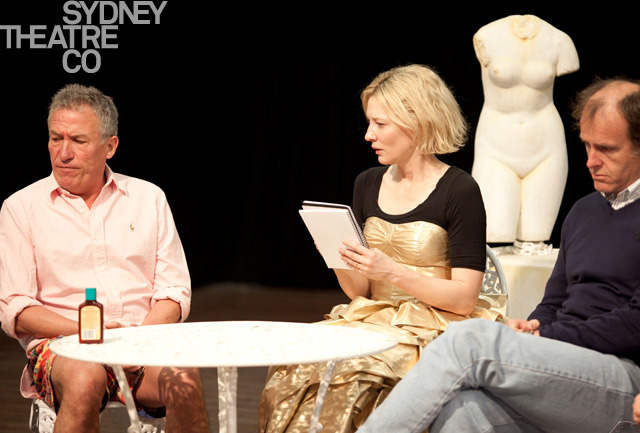
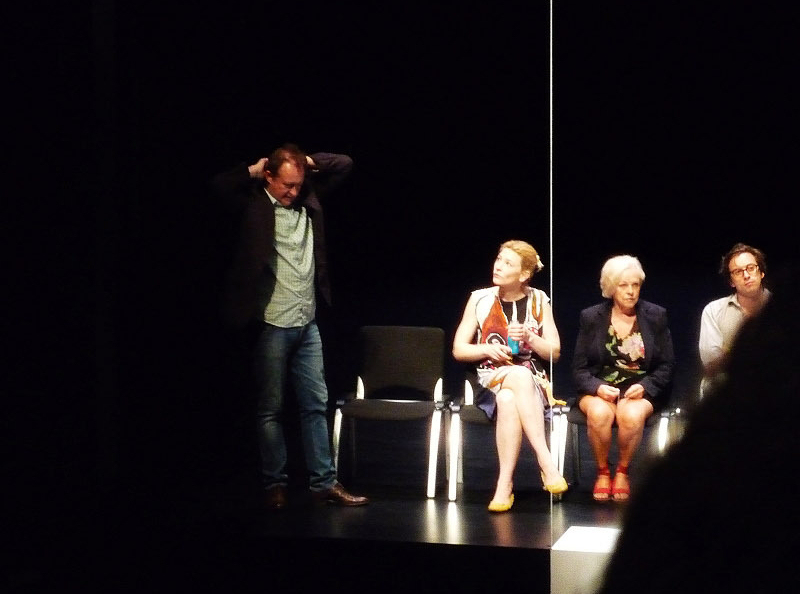
- On her character Lotte Kotte: “I see her as an emotional alchemist, trying to turn [lousy] situations into gold.” (New York Times, April 2012)
- “The translation by the English writer Martin Crimp is remarkable. He uses a concise, precise, and very rhythmic language. His text is a “recreation” in a way, a language of today. As for what Botho Strauss grasped in 1978, when he wrote Big and Small, what he testified to through Lotte’s wanderings from Morocco to Germany, I found it again in Sydney, while working. Great works have this power that they bear witness to their time and that, even more than thirty years later, they remain relevant today.” (Le Figaro, March 2012)
- “With this Lotte, Botho Strauss has created a female character who is more modern than ever. Lotte is in her mid-thirties, has no husband, no children, no job, she staggers through life. She wants nothing more than to be a part of society, but is too shrill, too stubborn, too annoying, or simply too Christian for that. She’s too much of everything, and yet it’s always too little… a funny, touching drama. In general, the whole theater trip is incredibly fun.” (Süddeustche Zeitung, May 2012)
- “There’s a great sense of alienation in the play and that’s expressed in the structure of the quite disparate scenes. But what’s been extraordinary with what Martin [Crimp, playwright and translator] has done has been to really bring out the humanity of the work.” (BBC, April 2012)
- “It was floating around everywhere as soon as it premiered in Germany. I first read it in the late Eighties and there was a very naive production I was part of, around 1987-8. My interest in the work was academic – I was interested in the play structurally. What has been remarkable [with this new production] is uncovering the humanity in the work. Maybe it’s my age but I also think it’s what Martin has unlocked. It still has this incredible rhythm and asymmetry, and yet it’s got a very beating heart.” (The Telegraph, April 2012)
Quotes from Others
- Benedict Andrews:
— On the play: “[Botho] Strauss wrote this very, very rare thing in theatre, which is a shining soul, a soul that radiates. It’s a very difficult thing to generate on stage. If you had an actor who didn’t have that within them – and Cate has this radiant quality, this Lotte essence – the whole point of the evening would die. One of the reasons why I want to go to theatre and why I want to make theatre is to meet extraordinary characters and you need great actors to do that.”
— On Cate Blanchett: “You can’t do this play without a perfect Lotte Kotte, and this was a perfect match for Cate, as the whole world now knows. You have to have a life force in the role. The role is a blank, and the motor has to be the soul of the comedienne.”
— “A lot of people see her as very elegant, very intense, luminous and intelligent, and a great beauty. She’s all of these things, but she’s also bloody funny, a great clown. We both thought the role should be funny.”
— “She’s a truly great actress. But she has a strong temperament, and in Big and Small, this may come as a surprise, but Cate is also a clown. The character is both a saint and a madwoman. Cate’s Lotte is a madman and a prophet…”
— “There is something special about this in that Lotte is also a clown. Part of the pleasure of the performance is seeing Cate’s clown and that’s not something I’ve necessarily seen in her before – that very playful, physical language is unique to this.” - Martin Crimp:
— On the play: “It was a complete revelation to me. When I read it in an existing translation, even through the fog of that translation I was attracted by it. It’s like a road movie in a way – but for the stage. It feels very open as a text and that’s what appealed to me. I also found affinities with this sense of someone being outside and wanting to find their way into the world – there’s a sense in my own work of discomfort with the world.”
Selected Reviews
Excerpts from selected reviews.
- AussieTheatre.com (Sydney) — “Cate Blanchett plays the lead role of Lotte and is the one link between the vignettes. The whole show is a search for belonging and we follow Lotte as she tries to hold it all together. Blanchett’s comedic timing is superb and right from the beginning she has the audience on a leash leading them from discovery to discovery. I kept thinking about how great she would be doing sitcom and that if they needed a player for an I Love Lucy biopic she would be perfect. Everything she does becomes high art. She is roundly supported by a rather large cast… all weave their way through Lottes life and are a stunning ensemble cast.
The end result is of a beautiful work that was restricted only by the restraints put on the cast in aid of layering the piece with extra symbol and extra subtext. The images created by the set were beautiful and could have been utilized more fully if there were less of them, or they weren’t used with music and movement and the falling paper spirals. The same with this stunning cast. If they were able to breathe and run free, not responsible for the set and entering and exiting continuously for the short scenes that could have flowed like a river without the layering of elements, then the play may have felt whole. It is so good to see a play like this attempted by the STC and is worth the price of admission for the performances alone.” - The New Statesman (Paris) — “I am a righteous person,” declares Lotte, the character played by Cate Blanchett in Botho Strauss’s play Big and Small (Gross und Klein), currently on show at Paris’s grand Théâtre de la Ville. The sentence is comic, Lotte having just been caught rifling through a dustbin, and grappling for an excuse to make the moment seem less awkward. Yet in many ways there is a touch of the visionary, a prophetic kind of quality to Lotte. Her Candidean perspective on things pervades this delicious production of the play by the Sydney Theater Company, and invites the audience to step through the looking glass into an adult Alice’s world.
Blanchett’s performance is magnetic. In scenes with music, Lotte gets carried away, dancing wildly, again with all the innocence of a child, only stopping when she realizes others are watching . As Blanchett dances away, running around the stage, Lotte’s raw passion is mesmerising.
In the final scene, the stage becomes a kind of claire-obscure, with Lotte, so striking with her pale skin, pale hair, and pale clothes, set in relief against the dreariness of those next to her, and the darkness around her. Lotte lights up the stage, and for those last moments of the play, we are almost convinced that she may very well be “righteous” after all.” - The Guardian (London) — “It’s not just the pitch-perfect range of Blanchett’s emotions that captivates; her balletic athleticism mesmerises throughout. She skips, she sprawls, she teeters and pirouettes and manages to imbue a simple walk across the stage with, depending on mood, exuberant gaucheness or filigreed elegance. At the very end, even her slouching exhaustion by life has an energy to it. There were four ovations from the audience, which I think we can safely wager is the first time for a while that London audience has felt that way about lengthy German surrealist drama. And they weren’t, trust me, applauding a Hollywood star. They were applauding the realisation that sometimes, just sometimes, a person truly deserves to be a star.”
- Independent (London) — “In Benedict Andrews’ production for the Sydney Theatre Company (of which she is one of the artistic directors), Blanchett proves she is as luminous and commanding a presence on stage as she is on screen.
Here, she portrays Lotte, a lonely graphic designer who embarks on a surreal odyssey across contemporary Germany in a fruitless search of some form of connection with old friends, an estranged husband, her brother’s berserk family – even at one point appearing like a bizarre, uninvited angel on the window sill of a bickering couple who wind up rejecting her intervention.
Establishing a winningly unguarded rapport with the audience, Blanchett manages to create a heroine who is both an open-hearted visionary able to retain a wonder and curiosity about the world, despite all the rebuffs, and a bit of a clown whose hapless antics are performed here with a balletically slapstick flair. Blanchett is magnificent throughout, especially in the later stages – at one point, she strips to a spangly gold tutu and wrestles with furious abandonment against an invisible God-figure; at another, she keeps involuntary channelling the deep voice of a deity while chatting to a nerd at a bus stop.” - The Times (London) — “Cate Blanchett gives a simply mesmerising performance as a woman edged out of her own life. But though her character, Lotte, runs the gamut from bumptiousness to woundedness, from irony to innocence, Blanchett ensures that Lotte’s playfulness is always underwritten by a sincere attempt to connect with people. This is a technically dazzling yet deeply felt portrayal of a woman increasingly unable to filter herself correctly in a changing society in which disconnection comes as standard.”
- Nachkritik (Vienna) — “Cate Blanchett is simply the perfect casting for the role of Lotte. The reviews in Sydney and London were rave, which meant that people in Vienna were already somewhat skeptical. They’ll just go and see “World Star on Stage” in Hall E of the Museumsquartier. It’ll be quite interesting, considering everyone’s come. All performances are sold out! Well then!
Yes, and then… you experience a “world-class actress” in a role that was created for her. It’s incredible what Cate Blanchett “performs” here, literally, for over two hours, constantly on stage! To portray a character so harrowing, vulnerable, shattered, yet strong and humorous, not just that of a woman, but that of a human being, and not just to play it, that is truly great acting. The way she uses her voice and her body is absolutely admirable, infinitely endearing, and touching, too.
All the other actors from the Sydney Theatre Company—and there are quite a few of them—Robert Menzies as the whining, mean husband Paul, Sophie Ross in multiple roles, Chris Ryan as the lonely chess club member, Richard Piper, to name just a few, play wonderfully with Cate Blanchett, not for her or around her. They embody the same old characters: the hypocrites, the snobs, the cynically self-righteous. But this play is Lotte’s big moment.
With the text translated by English playwright Martin Crimp, director Benedict Andrews has not only staged an Anglo-Saxon adaptation of Botho Strauss’s work, he has also given the play a new, contemporary dimension. It’s deeply sad, yet still makes you laugh a lot. That’s beautiful. And Cate Blanchett has reinvented Lotte.”
Trivia & Facts
- The play is Sydney Theatre Company’s co-production with other European theatre institutions: Ruhrfestspiele Recklinghausen (25 May to 2 June 2012), Wiener Festwochen (11-20 May 2012), Théâtre de la Ville Paris, (29 March to 8 April 2012).
- Cate Blanchett’s debut at the Barbican Theatre (13-29 April 2012).
- Cate Blanchett’s first time on stage in Paris and Vienna.
- Swiss opera and theater director Luc Bondy was supposed to direct the play but had to pull out due to health reasons, Benedict Andrews stepped in to the direct.
- Cate Blanchett was in a production of Gross und Klein while she was at university.
- Cate Blanchett and Benedict Andrews first collaborated in The War of the Roses (2009), their latest collaboration was in The Maids (2013-14).
- Lynette Curran and Cate Blanchett worked together as mother and daughter in the short film, Bangers (1999), by Andrew Upton. They also worked together in the play Mesmerized (1993).
- Cate Blanchett won Best Actress in a Play from 2011 Sydney Theatre Awards and 2012 Helpmann Awards, while she was nominated at 2012 Evening Standard Theatre Awards.


 Welcome to Cate Blanchett Fan, your prime resource for all things Cate Blanchett. Here you'll find all the latest news, pictures and information. You may know the Academy Award Winner from movies such as Elizabeth, Blue Jasmine, Carol, The Aviator, Lord of The Rings, Thor: Ragnarok, among many others. We hope you enjoy your stay and have fun!
Welcome to Cate Blanchett Fan, your prime resource for all things Cate Blanchett. Here you'll find all the latest news, pictures and information. You may know the Academy Award Winner from movies such as Elizabeth, Blue Jasmine, Carol, The Aviator, Lord of The Rings, Thor: Ragnarok, among many others. We hope you enjoy your stay and have fun! 
 A Manual for Cleaning Women (202?)
A Manual for Cleaning Women (202?) The Seagull (2025)
The Seagull (2025)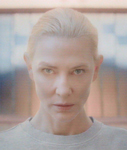 Bozo Over Roses (2025)
Bozo Over Roses (2025) Black Bag (2025)
Black Bag (2025) 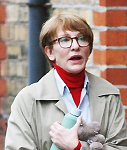 Father Mother Brother Sister (2025)
Father Mother Brother Sister (2025) 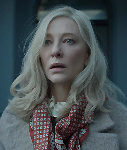 Disclaimer (2024)
Disclaimer (2024) 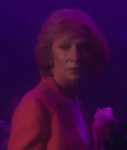 Rumours (2024)
Rumours (2024) 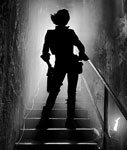 Borderlands (2024)
Borderlands (2024)  The New Boy (2023)
The New Boy (2023) 











